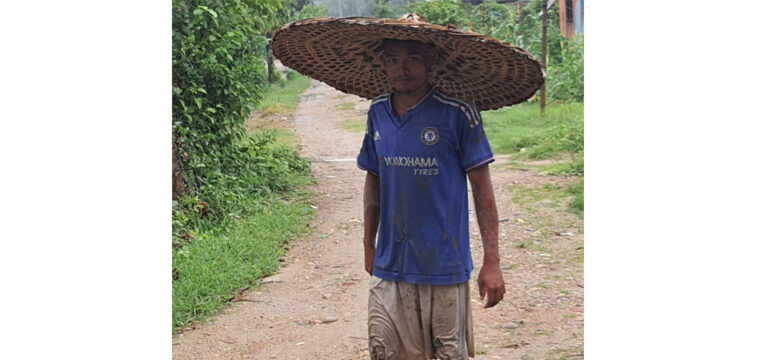
Bamboo parasols, traditionally known as Chhatris, the age-old symbol of monsoon in the Terai region are increasingly becoming rare.
Once a ubiquitous item, Chhatris have today taken a backseat to their more popular cousin, umbrellas. Created with heavier waterproof materials such as polyester and nylon, the modern-day umbrellas have come to be a much more comfortable alternative. While Chhatris are traditionally worn as caps, umbrellas have a curved handle to allow for easy grip.
Older generations fondly reflect back to the time when Chhatris were predominantly the choice among the general public.
Jhagaru Chaudhary, a senior citizen from Chandrapur Municipality Ward No. 6, vividly remembers donning a Chhatri and working in the rain during the peak paddy season. “With umbrellas, your hands aren’t free.
You have to keep holding on to the handle. This restricts movement. But using Chhatris, you efficiently work in the fields,” explains Chaudhary talking about the benefits of his traditional parasols over modern umbrellas. Because they allowed farmers to work on their fields even during heavy rains, Chhatris made more sense in Nepal’s fertile plains.
But why has it fallen out of fashion? According to Lallan Chaudhary of Bhawanipur, Gujara Municipality, several artisans of the bygone Chhatris have either given up their trade or are dead. “Chhatris are quintessentially a huge part of Tharu culture, or at least they used to be. However, due to the younger generation’s inclination to western practices, Chhatris aren’t produced anymore,” he says.
“Apart from being a unique aspect of Tharu culture, and a practical item, Chhatris are also environmentally more suitable,” adds Shyam Chaudhary, Mayor of Gujara Municipality. Parasols are typically constructed from more delicate fabrics such as lace, cotton, linen.
In the Tharu community, these shades are weaved out of bamboos and Phanera Vahlii leaves. “It’s a shame that young people have turned a blind eye to this gem of an item,” laments Mayor Chaudhary.
As per the hairperson of Federation of Nepalese Chambers of Commerce and Industry (FNCCI), Chandrapur Division, Sunil Kumar Sah, Phanera Vahlii plants, which are used to make Chhatris are also slowly disappearing from Nepal’s vegetation.
Dev Prasad Timilsina, a former member of the parliament from Rautahat, believes that the traditional culture of any community can be preserved only if the local level can formulate and implement an elaborate policy to preserve such traditional culture.
Source : TRN,





